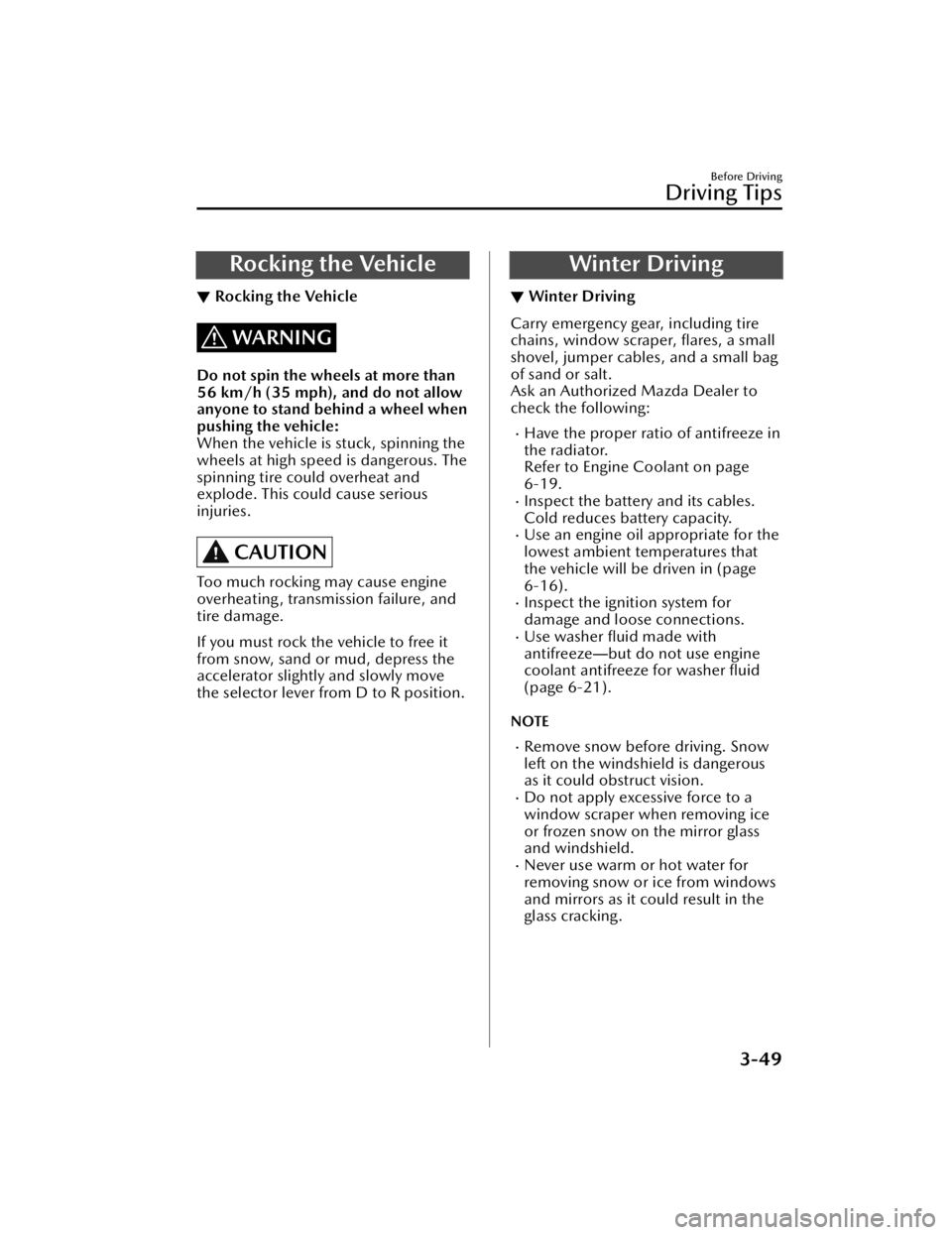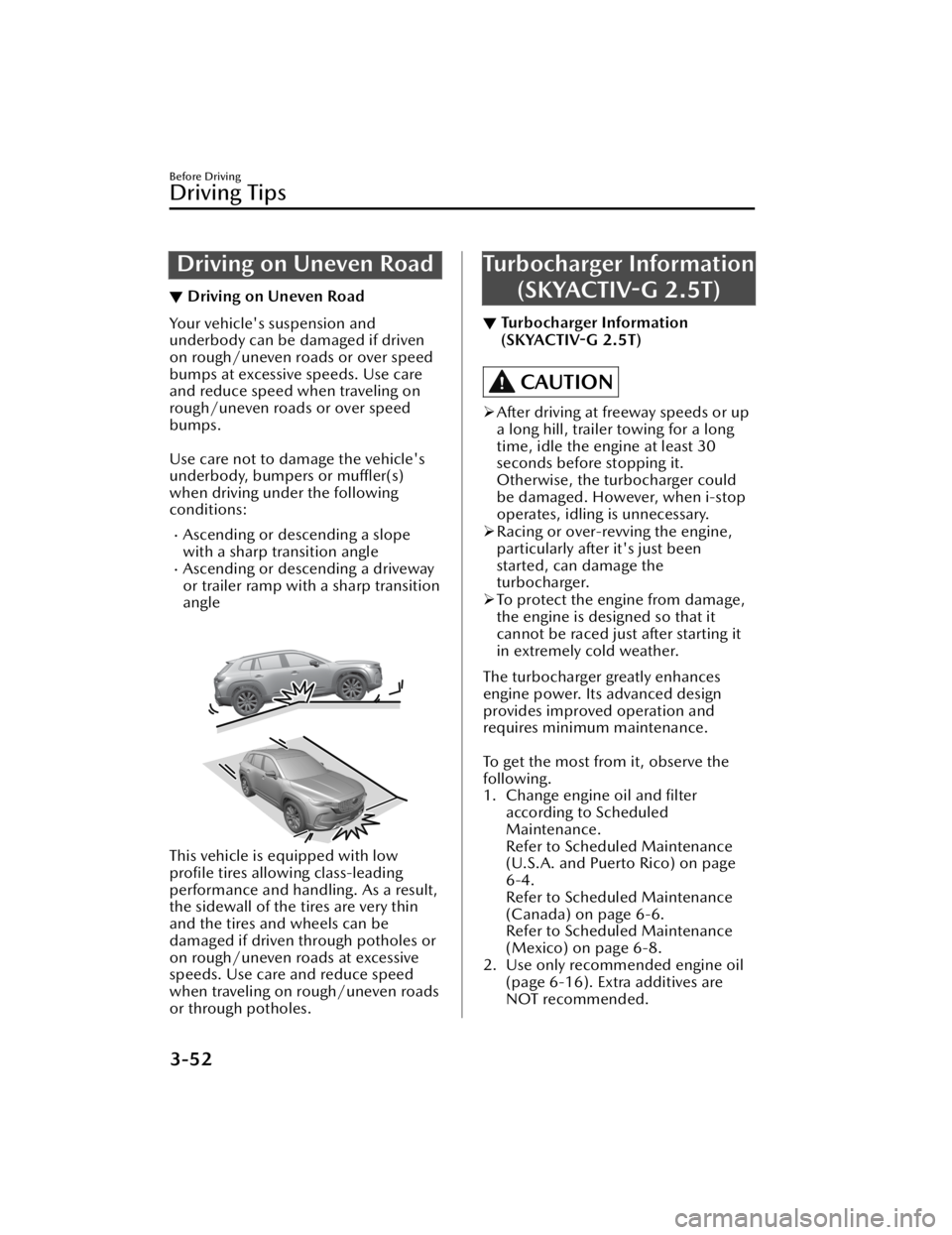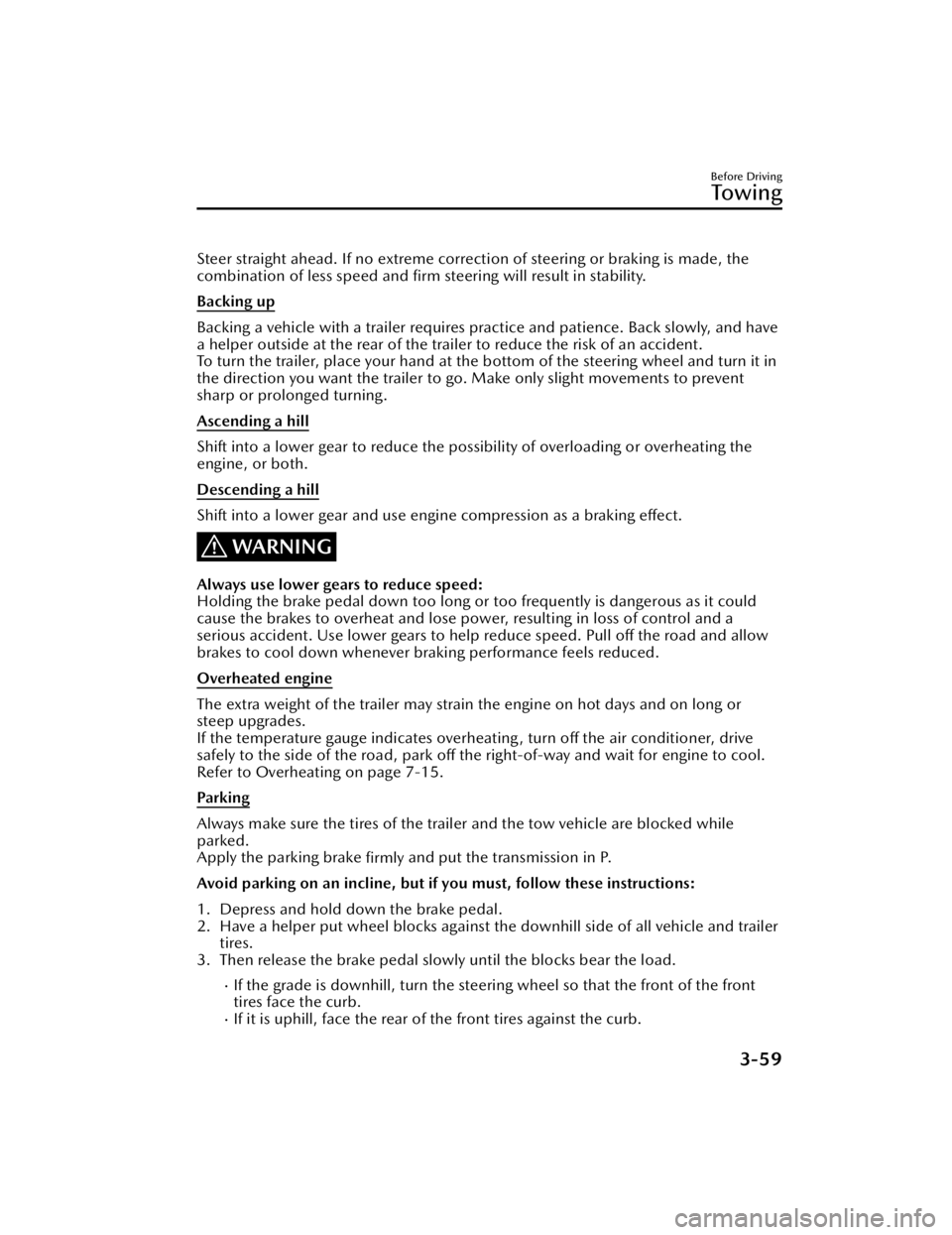engine MAZDA MODEL CX-50 2023 Owner's Manual
[x] Cancel search | Manufacturer: MAZDA, Model Year: 2023, Model line: MODEL CX-50, Model: MAZDA MODEL CX-50 2023Pages: 583, PDF Size: 85.63 MB
Page 134 of 583

The system will disarm if one of the
following operations takes place
within 20 seconds after pressing the
lock button:
Unlocking any door.Opening any door.Opening the hood.Switching the ignition ON.
To rearm the system, do the arming
procedure again.
When the doors are locked by
pressing the lock button on the
transmitter while the theft-deterrent
system is armed, the hazard warning
lights will flash once to indicate that
the system is armed.
▼ To Tu r n
Off an Armed System
An armed system can be turned off
using any one of the following
methods:
Pressing the unlock button on the
transmitter.
Starting the engine with the push
button start.
(With the advanced keyless
function)
Touching the sensing area of the
door release touch sensor.
The hazard warning lights will flash
twice.
NOTE
When the doors are unlocked by
pressing the unlock button on the
transmitter while the theft-deterrent
system is turned off, the hazard
warning lights will flash twice to
indicate that the system is turned off.
▼ To S t o p t h e A l a r m
A triggered alarm can be turned off
using any one of the following
methods:
Pressing the unlock button on the
transmitter.
Starting the engine with the push
button start.
(With the advanced keyless
function)
Touching the sensing area of the
door release touch sensor.
Pressing the electric liftgate opener
while the key is being carried.
The hazard warning lights will flash
twice.
Before Driving
Security System
3-45
CX-50_8KB8-EA-22A_Edition2_new 2022-1-6 14:55:18
Page 135 of 583

Break-In Period
▼Break-In Period
No special break-in is necessary, but a
few precautions in the
first 1,000 km
(600 miles) may add to the
performance, economy, and life of the
vehicle.
Do not race the engine.Do not maintain one constant
speed, either slow or fast, for a long
period of time.
Do not drive constantly at
full-throttle or high engine rpm for
extended periods of time.
Avoid unnecessary hard stops.Avoid full-throttle starts.Do not tow a trailer.
Saving Fuel and
Protection of the Environment
▼ Saving Fuel and Protection of the
Environment
How you operate your Mazda
determines how far it will travel on a
tank of fuel. Use these suggestions to
help save fuel and reduce CO
2.
Avoid long warm-ups. Once the
engine runs smoothly, begin driving.
Avoid fast starts.Drive at lower speeds.Anticipate when to apply the brakes
(avoid sudden braking).
Follow the maintenance schedule
and have an Authorized Mazda
Dealer perform inspections and
servicing.
Refer to Scheduled Maintenance
(U.S.A. and Puerto Rico) on page
6-4.
Refer to Scheduled Maintenance
(Canada) on page 6-6.
Refer to Scheduled Maintenance
(Mexico) on page 6-8.
Use the air conditioner only when
necessary.
Slow down on rough roads.Keep the tires properly inflated.Do not carry unnecessary weight.Do not rest your foot on the brake
pedal while driving.
Keep the wheels in correct
alignment.
Keep windows closed at high
speeds.
Slow down when driving in
crosswinds and headwinds.
Before Driving
Driving Tips
3-46
CX-50_8KB8-EA-22A_Edition2_new
2022-1-6 14:55:18
Page 136 of 583

WARNING
Never stop the engine when going
down a hill:
Stopping the engine when going down
a hill is dangerous. This causes the loss
of power steering and power brake
control, and may cause damage to the
drivetrain. Any loss of steering or
braking control could cause an
accident.
Hazardous Driving
▼Hazardous Driving
WARNING
Be extremely careful if it is necessary
to downshift on slippery surfaces:
Downshifting into lower gear while
driving on slippery surfaces is
dangerous. The sudden change in tire
speed could cause the tires to skid.
This could lead to loss of vehicle
control and an accident.
Avoid sharp turns, excessive speed
and abrupt maneuvers when driving
this vehicle:
Sharp turns, excessive speed and
abrupt maneuvering of this vehicle are
dangerous as it could result in the
increased risk of loss of vehicle control,
vehicle roll-over, personal injury or
death.
This vehicle has a higher center of
gravity. Vehicles with a higher center of
gravity such as util
ity vehicles handle
differently than vehicles with a lower
center of gravity.
Utility vehicles are not designed for
cornering at high speeds any more
than low profile sports cars are
designed to perfo rm satisfactorily
under off-road conditions.
In addition, utility vehicles have a
significantly higher rollover rate than
other types of vehicles.
In a rollover crash, an unbelted person
is significantly more likely to die than a
person wearing a seat belt.
When driving on ice or in water, snow,
mud, sand, or similar hazards:
Be cautious and allow extra distance
for braking.
Before Driving
Driving Tips
3-47
CX-50_8KB8-EA-22A_Edition2_new 2022-1-6 14:55:18
Page 138 of 583

Rocking the Vehicle
▼Rocking the Vehicle
WARNING
Do not spin the wheels at more than
56 km/h (35 mph), and do not allow
anyone to stand behind a wheel when
pushing the vehicle:
When the vehicle is stuck, spinning the
wheels at high speed is dangerous. The
spinning tire could overheat and
explode. This could cause serious
injuries.
CAUTION
Too much rocking may cause engine
overheating , transmission failure, and
tire damage.
If you must rock the vehicle to free it
from snow, sand or mud, depress the
accelerator slightly and slowly move
the selector lever from D to R position.
Winter Driving
▼Winter Driving
Carry emergency gear, including tire
chains, window scraper,
flares, a small
shovel, jumper cables, and a small bag
of sand or salt.
Ask an Authorized Mazda Dealer to
check the following:
Have the proper ratio of antifreeze in
the radiator.
Refer to Engine Coolant on page
6-19.
Inspect the battery and its cables.
Cold reduces battery capacity.
Use an engine oil appropriate for the
lowest ambient temperatures that
the vehicle will be driven in (page
6-16).
Inspect the ignition system for
damage and loose connections.
Use washer fluid made with
antifreeze ―but do not use engine
coolant antifreeze for washer fluid
(page 6-21).
NOTE
Remove snow before driving. Snow
left on the windshield is dangerous
as it could obstruct vision.
Do not apply excessive force to a
window scraper when removing ice
or frozen snow on the mirror glass
and windshield.
Never use warm or hot water for
removing snow or ice from windows
and mirrors as it could result in the
glass cracking.
Before Driving
Driving Tips
3-49
CX-50_8KB8-EA-22A_Edition2_new 2022-1-6 14:55:18
Page 140 of 583

Driving In Flooded Area
▼Driving In Flooded Area
WARNING
Dry off brakes that have become wet
by driving slowly, releasing the
accelerator pedal and lightly applying
the brakes several times until the
brake performance returns to normal:
Driving with wet brakes is dangerous.
Increased stopping distance or the
vehicle pulling to one side when
braking could result in a serious
accident. Light braking will indicate
whether the brakes have been
affected.
CAUTION
Do not drive the vehicle on flooded
roads as it could cause short circuiting
of electrical/electronic parts, or engine
damage or stalling from water
absorption. If the vehicle has been
immersed in water, consult an
Authorized Mazda Dealer.
Overloading
▼Overloading
WARNING
Be careful not to overload your
vehicle:
The gross axle weight rating (GAWR)
and the gross vehicle weight rating
(GVWR) of the vehicle are on the
Motor Vehicle Safety Standard Label
on the driver's door frame. Exceeding
these ratings can cause an accident or
vehicle damage. You can estimate the
weight of the load by weighing the
items (or people) before putting them
in the vehicle.
Before Driving
Driving Tips
3-51
CX-50_8KB8-EA-22A_Edition2_new
2022-1-6 14:55:18
Page 141 of 583

Driving on Uneven Road
▼Driving on Uneven Road
Your vehicle's suspension and
underbody can be damaged if driven
on rough/uneven roads or over speed
bumps at excessive speeds. Use care
and reduce speed when traveling on
rough/uneven roads or over speed
bumps.
Use care not to damage the vehicle's
underbody, bumpers or
muffler(s)
when driving under the following
conditions:
Ascending or descending a slope
with a sharp transition angle
Ascending or descending a driveway
or trailer ramp with a sharp transition
angle
This vehicle is equipped with low
profile tires allowing class-leading
performance and handling. As a result,
the sidewall of the tires are very thin
and the tires and wheels can be
damaged if driven through potholes or
on rough/uneven roads at excessive
speeds. Use care and reduce speed
when traveling on rough/uneven roads
or through potholes.
Turbocharger Information (SKYACTIV-G 2.5T)
▼Turbocharger Information
(SKYACTIV-G
2.5T)
CAUTION
After driving at freeway speeds or up
a long hill, trailer towing for a long
time, idle the engine at least 30
seconds before stopping it.
Otherwise, the turbocharger could
be damaged. However, when i-stop
operates, idling is unnecessary.
Racing or over-revving the engine,
particularly after it's just been
started, can damage the
turbocharger.
To protect the engine from damage,
the engine is designed so that it
cannot be raced just after starting it
in extremely cold weather.
The turbocharger greatly enhances
engine power. Its advanced design
provides improved operation and
requires minimum maintenance.
To get the most from it, observe the
following.
1. Change engine oil and filter according to Scheduled
Maintenance.
Refer to Scheduled Maintenance
(U.S.A. and Puerto Rico) on page
6-4.
Refer to Scheduled Maintenance
(Canada) on page 6-6.
Refer to Scheduled Maintenance
(Mexico) on page 6-8.
2. Use only recommended engine oil (page 6-16). Extra additives are
NOT recommended.
Before Driving
Driving Tips
3-52
CX-50_8KB8-EA-22A_Edition2_new 2022-1-6 14:55:18
Page 142 of 583

Trailer Towing (U.S.A. and Canada)
▼Trailer Towing (U.S.A. and Canada)
Your Mazda was designed and built primarily to carry passengers and cargo.
If you tow a trailer, follow these instructions because driver and passenger safety
depends on proper equipment and safe driving habits. Towing a trailer will
affect
handling, braking , durability, performance, and fuel economy.
Never overload your vehicle or trailer. Co nsult an Authorized Mazda Dealer if you
need further details.
CAUTION
Do not tow a trailer during the first 1,000 km (600 miles) of your new Mazda. If you
do, you may damage the engine, transmission, differential, wheel bearings, and
other power-train components.
NOTE
When towing, use of gasoline with a octane rating of 91 or higher is
recommended.
Your vehicle is equipped with a Mazda intelligent Drive Select (Mi-Drive) towing
mode* which enhances vehicle stab ility when towing a trailer.
Refer to Mazda intelligent Drive Select (Mi-Drive) (AWD) on page 4-83.
When towing a trailer, do not use the following safety systems (If a Mazda genuine
trailer hitch is used, these systems are automatically turned off):
Blind Spot Monitoring (BSM)Rear Cross Traffic Alert (RCTA)Smart Brake Support [Rearward detection function]Smart Brake Support [Rear crossing]Parking Sensor System (Rear)Blind Spot Assist of Emergency Lane Keeping (ELK)
▼ We igh t L imits
TTW and GCWR
The total trailer weight (TTW), gross comb
ination weight rating (GCWR), gross axle
weight rating (GAWR), trailer load, and trailer tongue load must be within the
prescribed limits.
The total trailer weight (TTW) is the sum of the weights of the trailer load (trailer
weight plus cargo), trailer hitch, 2 passengers, and vehicle load (baggage, food,
camp gear, etc.). Never allow the total trailer weight (TTW) to exceed
specifications in the Trailer Towing-Load Table.
The maximum GCWR is the combination weight of the trailer and load plus the
towing vehicle (including trailer hitch, ve hicle passengers, and load). It must not
exceed the specifications in the load table.
Before Driving
Towing
*Some models.3-53
CX-50_8KB8-EA-22A_Edition2_new 2022-1-6 14:55:18
Page 143 of 583

GAWR and GVWR
Do not exceed front and rear GAWR (gross axle weight rating) and GVWR (gross
vehicle weight rating). If you do, vehicle handling , braking , and performance will be
affected. These values are also on the Motor Vehicle Safety Standard Label posted
on the driver's door frame.
High-altitude operation
CAUTION
Be aware of the towing load weight differe nces when towing at high altitudes. For
altitudes exceeding 1,000 meter (3,280 ft 10 in), always reduce the towing load by
10 % for every 1,000 meter (3,280 ft 10 in) increase in altitude from the load
indicated under the maximum GCWR heading in the trailer towing-load table. If the
determined maximum total towing load we ight is exceeded, the engine and other
power-train parts may be damaged.
TRAILER TOWING-LOAD TABLE
Because vehicle weights vary, adjustments must be made to meet the requirements
in this table.
Item Model
SKYACTIV-G 2.5 SKYACTIV-G
2.5T
FWD AWD AWD
MAX. FRONTAL
AREA
2.79 m2 (30 ft2)
MAX. TTW
907 kg (2,000 lb) 1587.5 kg
(3,500 lb)
MAX. GCWR
2,704 kg
(5,961.2 lb) 2,829 kg
(6,236.8 lb) 3,554 kg
(7,835.1 lb)
MAX. GAWR
Front 1,090 kg
(2,403.0 lb) 1,133 kg
(2,497.8 lb) 1,182 kg
(2,605.8 lb)
Rear 996 kg (2195.7
lb) 1,079 kg
(2,378.7 lb) 1,073 kg
(2,365.5 lb)
MAX. GVWR
2,074 kg
(4,572.3 lb) 2,199 kg
(4,847.9 lb) 2,243 kg
(4,944.9 lb)
Before Driving
To w i n g
3-54
CX-50_8KB8-EA-22A_Edition2_new 2022-1-6 14:55:18
Page 148 of 583

Steer straight ahead. If no extreme correction of steering or braking is made, the
combination of less speed and firm steering will result in stability.
Backing up
Backing a vehicle with a trailer requires practice and patience. Back slowly, and have
a helper outside at the rear of the trai ler to reduce the risk of an accident.
To turn the trailer, place your hand at the bottom of the steering wheel and turn it in
the direction you want the trailer to go. Make only slight movements to prevent
sharp or prolonged turning.
Ascending a hill
Shift into a lower gear to reduce the possibility of overloading or overheating the
engine, or both.
Descending a hill
Shift into a lower gear and use engine compression as a braking effect.
WARNING
Always use lower gears to reduce speed:
Holding the brake pedal down too long or too frequently is dangerous as it could
cause the brakes to overheat and lose power, resulting in loss of control and a
serious accident. Use lower gears to help reduce speed. Pull off the road and allow
brakes to cool down whenever braking performance feels reduced.
Overheated engine
The extra weight of the trailer may strain the engine on hot days and on long or
steep upgrades.
If the temperature gauge indicates overheating, turn off the air conditioner, drive
safely to the side of the road, park off the right-of-way and wait for engine to cool.
Refer to Overheating on page 7-15.
Pa r k i n g
Always make sure the tires of the trailer and the tow vehicle are blocked while
parked.
Apply the parking brake firmly and put the transmission in P.
Avoid parking on an incline, but if you must, follow these instructions:
1. Depress and hold down the brake pedal.
2. Have a helper put wheel blocks against the downhill side of all vehicle and trailer tires.
3. Then release the brake pedal slowly until the blocks bear the load.
If the grade is downhill, turn the steering wheel so that the front of the front
tires face the curb.
If it is uphill, face the rear of the front tires against the curb.
Before Driving
Towing
3-59
CX-50_8KB8-EA-22A_Edition2_new 2022-1-6 14:55:18
Page 149 of 583

4. Firmly apply the parking brake.
5. Shift the transmission into P, and stop the engine.
To restart after parking on an incline:
1. With the transmission in P, start the engine. (Be sure to depress and hold thebrake pedal.)
2. Shift into gear.
3. Release the parking brake (also the foot brake) and pull away from the wheel blocks. Stop; apply the parking brake and shift into P.
4. Have a helper retrieve the wheel blocks.
Fuel consumption
Trailer towing causes higher fuel consumption.
Maintenance
If you tow a trailer frequently, have your vehicle serviced as shown in Scheduled
Maintenance (page 6-4).
Before Driving
To w i n g
3-60
CX-50_8KB8-EA-22A_Edition2_new 2022-1-6 14:55:18